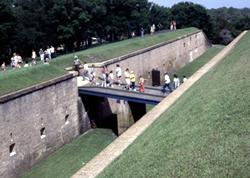
|
|
Photo courtesy of the
Florida Division of Historical Resources.
|
The bluffs overlooking Pensacola Bay have been strategically important since the first European explorers landed nearby. Before Fort Barrancas was built, two other forts protected the entrance to the bay from the overlook. Fort San Carlos de Austria was an early Spanish earth and log fort that fell to the French in 1722. During the British occupation of Florida the Fort at Red Cliffs was built in 1771 and renamed Royal Navy Redoubt in 1781. During the second Spanish occupation, Batería de San Antonio was added to the fort in 1797, now named Fort San Carlos de Barrancas (Spanish for "bluffs"). In 1814, British troops fleeing General Andrew Jackson rendered the fort useless by damaging cannons, blowing up a magazine, and burning wooden structures.
Modern Fort Barrancas was built on top of the bluff overlooking Batería de San Antonio. Construction began in 1840 and incorporated many unusual design features to accommodate the sandy bluff. Partially completed in 1846, Fort Barrancas boasted 37 guns. In 1847, construction of the Advance Redoubt was begun to protect the northern land approach. During the Civil War, Fort Barrancas was held by Confederate forces until 1862. Occupied by a single garrison after the war, the fort languished until 1890 when it was re-armed as a training facility. Used briefly during the Spanish-American War, Fort Barrancas was disarmed in 1900 and served as an observation and communications post until 1930. World War II proved once and for all that coastal brick and mortar forts were obsolete and Fort Barrancas, onboard Pensacola Naval Air Station, was deactivated in 1947. In 1971, the structure became part of the Gulf Islands National Seashore; restoration of Fort Barrancas began in 1978.
|






